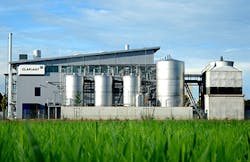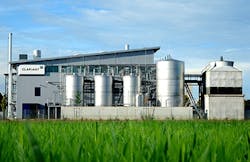Bioethanol Process Nears Commercialization
The first commercial plant to use the Sunliquid process to convert agricultural residues into cellulosic ethanol now is under construction. Process-developer Clariant, Muttenz, Switzerland, broke ground in mid-September on the €100 million (≈$116 million) facility near Craiova, Romania. The 50,000-mt/yr plant will be able to process up to ≈250,000 mt/yr of straw from wheat and other cereals. Byproducts will go to generating energy, with the goal of making the facility independent of fossil fuel. The plant is expected start up in 2020.
The process starts with mechanical pretreatment — milling the straw and removing any unwanted materials such as stones and dust.
Figure 1. Company validated process design and equipment at 1,000-mt/yr plant in Straubing, Germany. Source: Clariant.
Then, thermal pretreatment further breaks down the straw and makes the cellulose and hemicellulose more accessible to enzymes used in the subsequent saccharification step.
“Pretreatment is carried out in a one-stage reactor, whose design and performance has already been validated on a commercial scale by the pulp and paper industry,” explains Paolo Corvo, head of sales and marketing with Clariant’s biofuels and derivatives business.
This chemical-free process relies on steam, pressure and Clariant’s own tailor-made enzymes to obtain a substrate known as mash, some of which is used for enzyme production.
The rest undergoes a three-stage ethanol purification process in a unit equipped with state-of-the-art multistage distillation and heat-recovery technology that the company says reduces energy demand by 50% compared with conventional distillation.
The mash first enters the mash (or beer) column, where alcohol is concentrated and then sent as raw ethanol to the rectification stage. This further concentrates the ethanol stream and purifies it by removing side-products. The final ethanol dehydration stage removes remaining water with molecular sieves to yield 99.8%-pure bioethanol.
Clariant began its Sunliquid development work on a 2-mt/yr pilot plant in Munich, Germany, in 2009, and followed this up in July 2012 with the commissioning of a 1,000-mt/yr demonstration facility at Straubing, Germany (Figure 1).
“Before going into the next phase, we made sure that the previous steps were fully proven and optimized. We are only using validated equipment and have always been following a very straightforward process design. We put this strong focus on only using established process equipment from other industries in order to reduce the risk with technology upscaling,” stresses Corvo.
Clariant is offering Sunliquid process design packages for commercial plants ranging from 50,000 mt/yr to 150,000 mt/yr.
“Scaling up the technology and equipment to this capacity is not the challenge. Rather, this lies in the aggregation and delivery of the feedstock volume needed for such a scale,” Corvo concludes.

